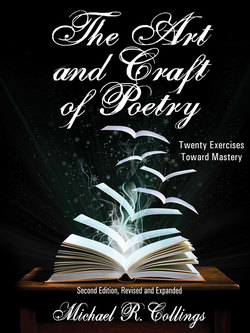Читать книгу The Art and Craft of Poetry - Michael R. Collings - Страница 3
На сайте Литреса книга снята с продажи.
ОглавлениеFOREWORD
While many of the poems referred to as models have been posted on internet sites, some exercises in this sequence are keyed to materials in the following books, although it is not necessary to purchase them in order to explore the possibilities of poetry presented here:
Drury, John. The Poetry Dictionary. Cincinnati OH: Story Press, 1995. [Drury]. Drury is particularly valuable for its detailed discussions of literary forms and movements. The sections need not be read in sequence.
Rosengarten, Herbert, and Amanda Goldrick-Jones, eds. The Broadview Anthology of Poetry. Peterborough, Ontario, Canada; Orchard Park NY, 1993. [TBAP]. The Broadview Anthology provides access to poetry from Chaucer to the present, many of which will form the kernel of discussion; at the same time, the anthology allows students to explore professional-level writing.
Several additional texts are highly recommended for any writers, primarily as adjuncts to the writing process:
Hodges, John C. and Mary E. Whitten. Harbrace College Handbook. Current edition. Poets frequently defy the conventions of language, re-defining the functions of punctuation marks, grammatical structures, etc., for poetic purposes. However, in almost every case, the poets in question fully understand the conventions before altering them. Effective poetry must convince their readers that, in spite of experimental surfaces, the poets understand the underpinnings of English grammar and usage.
Collegiate Dictionary, such as The American Heritage Dictionary. Current edition. The same caveat holds for spelling: contemporary poetry often re-works and reforms words, but before poets do that they must be familiar with the standards they are rejecting. Effective poems must convince their readers that any aberrant forms are purposeful rather than accidental or stemming from ignorance.
The accompanying exercises are designed primarily for writers already acquainted with the rudiments of poetry: meter, rhythm, rhyme, figures, images, etc. While several pages are devoted to definitions and discussions, most of The Art and Craft of Poetry concentrates on exercises and, most frequently, college students’ responses to those exercises.
Most of the poems included as examples come from students in intermediate Creative Writing classes over the past twenty years. These poems and others like them formed the basis of discussion in classes spanning over fifteen years.
Note: Many of the student poems—here reproduced as originally submitted, without the benefit of subsequent revising—are unusually well done; others demonstrate common weaknesses, and close readings may suggest serious problems as well as ways other writers might avoid those dangers. All, however, show a commitment to writing, to poetry, and to art. They are included to demonstrate individual responses to poetry; as student works or works-in-progress, they are intended to provide models for discussion. You are encouraged to read them, assess their effectiveness as poetry for you, and emulate the strengths you find in them.
I am particularly grateful to the following former students for allowing me to incorporate their voices into this handbook: Janna Anderson, Lisa Bates, Carter Boisvert, Joanie Chan, Ethan Collings, Ty de Long, Alex Duncan, Robert Efford, Allison Elms, Christian Hawkey, Erin Kayler, Kim Kooyers, Marnee Lewis, Mercedes Martinez, Adrienne Maxwell, Tamar Moore, Rachel Moreno, Matt Oden, Nichole Paré, Alan Regan, Keith Skilling, Michael Strickland, Amy Vicker, Jason Wall, Chad Weiss, and John Weseley. Without their dedication as students and writers, this handbook would not have been possible.
—Michael R. Collings
Meridian, Idaho
March 2009
